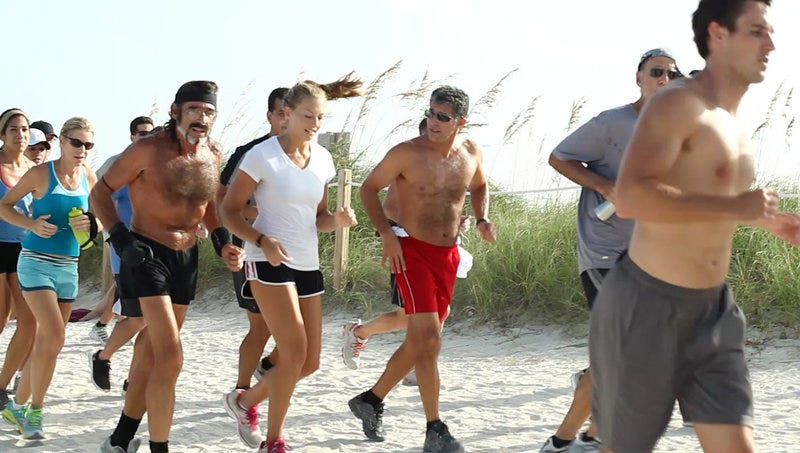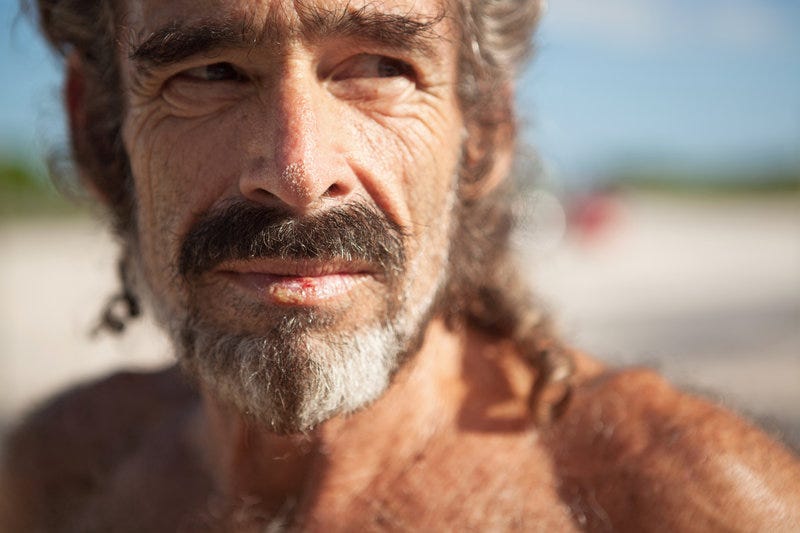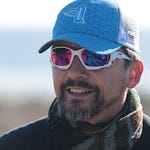'Raven has a way of drawing out the uniqueness in people.'
Good Sunday morning, my friends! ☀️
Our next book club pick and discussion is one I’m really, really excited about, as I had the chance to speak earlier this week with Laura Lee Huttenbach, the author of Running With Raven.
For those of you who aren’t familiar with her work, Huttenbach grew up in Atlanta, where she was a star athlete in four sports (including cross country), and in high school was named Georgia’s Female Athlete of the Year.
Today, she is a freelance writer based in New York City after several years spent living in Miami Beach, where she moved in 2011 and met Robert “Raven” Kraft by chance on the beach one day. Intrigued by his story, and the tribe of runners alongside him, she decided to join one of his afternoon runs, and the rest is history.

Photo by Mary Beth ‘Yellow Rose’ Koeth, a fellow Raven runner
A quick housekeeping note: we’ll conduct our book club discussions like we did for Running With Sherman — let’s plan on discussing the first six chapters in our first installment, which I’ll send out next Friday, March 20.
On the following two Fridays (March 27 and April 3), we’ll discuss chapters 7-13 and chapters 14-19, respectively. Just let me know if you need more time, by the way, and I can adjust this schedule.
Laura Lee and I spoke about Raven, running and the impact he has had on the lives of hundreds (thousands, perhaps) of people who have joined him on the run over the years.
Right before our interview, she added, she spoke with Raven by phone and said he’d be open to joining us for an interview and/or a live discussion as well — which I think we’d all get a huge kick out of! Let me know what you think. 😀
— Terrell
Terrell Johnson: This is a really different kind of running book; most books about running are by professional runners or people who are really at a high level — the Dean Karnazeses and Deena Kastors and Kara Gouchers of the world. Raven is a more ordinary, down-to-earth person. What drew you to writing about him?
Laura Lee Huttenbach: I have a background in cross country running in high school, but I never really got into the super technical side of running. I just would put on my running shoes and go outside and like to run a fast three or five miles. And I usually did it by myself.
When I moved to Miami Beach — that's a special place to live and run — and I would pass him running. On the front cover of the book is Raven with a really hairy chest and a mullet, and he wears a headband and always black shorts. And so he definitely calls your attention, and I just was immediately curious about why he was running at the same time every day and who are all these people running with him where that were a real diverse group of individuals.
TJ: You mentioned Miami beach is a really special place. What is it about Miami?
LLH: It's gone through a ton of changes, of which Raven has been an observer and participant and because he's run in the exact same place for 45 years. He can tell you about the changes in the city, from taking the exact same path every day.
There's a joke you hear from people in Miami Beach. They say if you are somebody, you go to New York; if you want to be somebody, you go to L.A.; if you want to be somebody else, you go to Miami. It’s a pretty transient town — a lot of people in Miami aren't from Miami, and [you] can have this luxury of creating the identity that you want to have there.
‘[Raven] does what he says he's going to do. He runs every day, and he's just this genuine person. He doesn't have a cell phone. He's never ridden in an airplane. He doesn't have a passport. He doesn't have a driver's license.’
But it can have this reputation of people not always being who they say they are, or who they represent themselves as. And so navigating that landscape, and of course it is a stereotype, there's a lot of people that are, that don't follow that. I met some of my nearest and dearest friends while I was living there.
Raven is pretty much the opposite of that stereotype. He's not a showy individual, he does what he says he's going to do. He runs every day, and he's just this genuine person. He doesn't have a cell phone. He's never ridden in an airplane. He doesn't have a passport. He doesn't have a driver's license.
When I started running with Raven, I noticed one thing that people seem to have in common that were with him was that they were either striving to be more authentic to themselves or they just were more authentic individuals. And that was really attractive to me to see just a group of people that was trying to be closer to themselves and who they were.
Raven has a way of drawing out the uniqueness in people. I think he considers himself a character, and I think he likes seeing the character parts of other people. So he'll draw that out of you if you are not sure what your quirk is. Raven will probably find it in the conversation and he'll give you a nickname like naming you for your quirkiness.
TJ: For a reader who's new to the book, how would you describe Raven to someone who'd never heard of him, who didn’t know anything about him?
LLH: His claim to fame — and a lot of news stories about him focus on this, of course — is the running streak. In 1975, he made a new year's resolution to run eight miles every day without exception on the sands of South Beach. And he has continued that streak every single day up until now.
So this past January was 45 years of running eight miles every day on the sand. And that would already make him a pretty unique individual. There are some runners that have maintained longer streaks than him. But one thing that makes him, or a couple of things that make him unique in his streak is that he hasn't run alone maybe even once in the last 14 years by himself.
Every single day, runners have shown up. They meet at the 5th street lifeguard stand in Miami Beach and run with him. So when you think about the weather in Miami, and the hurricanes they get, and the tropical storms and the rain storms and all of that — it's a pretty amazing thing that people have shown up to run even in the bad weather with him.

Laura Lee ‘White Lightning’ Huttenbach (in white shirt) runs alongside Raven during a run on South Beach. Photo by Mary Beth ‘Yellow Rose’ Koeth.
I just got off the phone with him before we talked and he told me that [he] thinks today it's 132,360 miles that he run and 16,506 days [in a row].
TJ: That’s just amazing.
LLH: He keeps track of his mileage and the days and also the runners that run with him. So if you're a regular runner, when you show up or even if you're not a regular runner, when you show up he'll be like, "hey, good to see you man. Today is run number 2000 whatever." Or, you're at so many miles and there's like little milestones that people can get. So like when I ran my 1000th mile with Raven, he gave me a little black wristband that he gave me that says, “Raven Run.” And so he also really tries to make it feel like a community and an institution.
What a lot of stories [on Raven] I thought didn't necessarily focus on is the community that he's created and he, every single day that someone in Miami — either living there or just visiting — if they're a runner or curious about this community, you can go and show up and it's free. It's open and it's inclusive and you can meet people doing something healthy, and that's pretty special... he's a pretty unique fellow.
TJ: It seems like that was a theme that runs through [the book] for a lot of people who would join him on the run. And what do you think he wanted to be? What is he seeking? What are the people who come out and run with him seeking?
LLH: In the book, you learn more about his background and his family dynamics and his career. But he always kind of felt like an outcast. And I would say his greatest fear is of abandonment; he moved around a lot as a kid, lots of different apartments and homes. And so I think he really wanted to establish a permanence and also feel like he was part of a family and feel like he had accomplished something.
He didn't have a super strong athletic pedigree, growing up. When he started running, he met these two boxers at the 5th street gym name Killer and Bulldog, and they took him running. When he ran those two miles with them, he really felt like he had accomplished something and the adrenaline was pumping and he felt healthy.
‘Everyone wants to feel needed and missed and that their presence is bringing value to a space. And I think the run has definitely given that to Raven.’
And then as they run, as he started running a little more, he got more specific on the time that he started. And so it developed really into this consistent pattern. Because he felt his life was a little bit chaotic too, he really used to the run as a structure. And in the first decade or two, he didn't really have a lot of things — he didn't really have as many people running with him. It was really just for himself — structure, discipline, putting his life in order and feeling like he had accomplished something every day.
Later, when he got a little more publicity and more people running with him, I think the other elements fell into place — feeling like he has a family, and so other people motivate him to come out now.
In our society today, I think a lot of people are — although there's so many opportunities to connect virtually on Facebook and so many risk things come from that as you know from your newsletter (you all really have created a special community as well) — there's some element of actually showing up and seeing people.
And, because Raven doesn't have a cell phone, he's not texting on the run. He's just there and running. So I think people that are seeking structure and seeking a sense of a permanence or greater permanence — I think are drawn to Raven.
What you mentioned at the beginning, of this not being your typical runner's guide or runner's book — I definitely don't think many people will put down Running With Raven and be like, "what a great idea. I'm going to spend the next 45 years of my life running eight miles every day and not missing a day and I'm going to start a streak!"
But it might spark something that you've been meaning to do or some habit that you've been trying to cultivate and say, "I'm going to try this out and see how it changes my life and try to stick to it." And yeah, I don't think it would be wise to necessarily follow exactly, but I think there are things you can take from Raven's story that might be useful to people in their own lives.
TJ: You mentioned a moment ago, he did this for a decade really before anyone noticed. [I wonder] how many runs he just did all by himself out there, for years probably? Raven has said it gives him a sense of purpose. Now, I imagine that the people coming out, he feels a responsibility to them as much as to the run itself.
LLH: It's definitely evolved into that. I think he used to show up for his own benefit and hiss own discipline and structure. But now he also shows up and is motivated by other people showing up — he doesn't want to disappoint other people and he knows that people are going to be there and waiting for him and expect him to show up.
And he really finds that very fulfilling. Everyone wants to feel needed and missed and that their presence is bringing value to a space. And I think the run has definitely given that to Raven.
TJ: How's he doing today? Because 45 years — that's a long, long time!
LLH: in the book I describe him as having a body that looks kind of like an apostrophe. Certainly, the miles have taken their toll. He has a spinal stenosis, and sciatica, and some scoliosis, and his feet hurt. So definitely has issues with chronic pain. And because of the streak running culture, when you have a little ache or a sports injury, the standard would probably be take a few days of rest. Relax, let it heal. But he doesn't follow those orders at all. He's also been recommended as a good candidate for having surgery but wouldn't want to do the recovery because that would keep him off the stand.
So the first few miles [of the eight] are usually pretty tough on him. But then, as he gets a little loosened up, they're a little bit easier. But certainly he's battling some aches and pains and running a lot slower. When he first started out he was running a 7:30 pace.
TJ: On the sand?!
LLH: On the sand, yes! And even when I started running with them in 2011 it was, I don't know, I didn't actually pace anything; it's just not that type of run.
Usually ... Raven doesn't really even like talking about that much, like any kind of technical aspects of running. So, he's probably not someone that would be impressed a lot by talking about your times on different races or anything. So yeah, when I started running with him in 2011, I don't know how fast he was, maybe a 10-minute mile or 11-minute miles, I have to guess. But now it's more like a 14 minute mile maybe.
For some runners, that's still an accomplishment. There's runners that are in their 70s and 80s running with him and that's great. That they get out and run with him at that pace. But for the runners that are accustomed to doing a faster pace, the thing you get out of running with Raven isn't necessarily just like a remarkable training exercise, but the community and the stories and honoring his legacy.
TJ: The book has been out about three years now. What has been the reaction to it, and has anything surprised you?
LLH: Well, my favorite response was usually a Facebook message or comments on my website or something that says like, “hey, I'm going down to run with Raven in two weeks. What time does the run start again?" And [others who tell me they] loved the book, want to get a nickname. So those are definitely my favorite responses.
Whenever you write something, you can't control how the reader is going to interpret a story and for the most part it's been super-positive. Sometimes I'll get readers that are like, this guy is crazy. What were you doing writing about him? But that's fine too. Again, it comes back to the point of, I never wrote this to be a runner's guide.
‘Every day I lived in Miami Beach, I knew where I could find one friend.’
I'm sure all runners have gotten questions from their loved ones: “it's freezing outside, what are you doing running? You pulled your quad the other day. Why are you back out running?" So, there is a bit of insanity to voluntarily doing what we do. I think Raven just takes that to another level.
But yeah, there the response has been just positive and even from non-runners that read the book, I think they pull something out of Raven's character or just the stories of South Beach. It's such a diverse city that there are a lot of characters that Raven tells stories of. So you don't have to be a runner to read it. There are maybe some inside winks of if you are a runner. But I think people interested in just any complicated individual's story, or in South Beach, will get a kick out of his story.
TJ: Now that the book has been out for a while, what should people know about Raven today?
LLH: Raven's still running. So if someone has plans to go to South Beach, [you] are invited and welcome to join Raven on an eight-mile run. When you finish the eight miles, that's when you get a nickname. We all know one another in the community by our nicknames... And so when Raven writes me letters, he addresses them to White Lightning, which is my nickname.
I'm really excited that you all chose Running With Raven for your book club selection and I just hope people like the book and that it's entertaining and that it speaks to everyone in a different way.
TJ: Do you keep in touch with any of the people that you used to run with when you were living in Miami?
LLH: Two of my best, best friends are Raven runners. One of them Yellow Rose or Mary Beth Koeth. She's a photographer and she actually did a documentary about Raven called The Unstoppable Man and she's still in Miami. We chat all the time. And then another dear friend Jurisprudence, her real name is Becca and she also lives in New York. I have some very dear friends from Miami and
There's no one in New York doing what Raven is doing — there are definitely runner groups and a lot of opportunities to be social while running and meet people with common interest. But what I mentioned earlier, the fact that every day that I lived in Miami Beach, I knew where I could find one friend.

Raven, photographed by Mary Beth ‘Yellow Rose’ Koeth.
More
Buy Running With Raven on Amazon here, at Barnes & Noble here, or from the independent bookstore Avid Bookshop here.














Book Club Kickoff: A conversation with 'Running With Raven' author Laura Lee Huttenbach